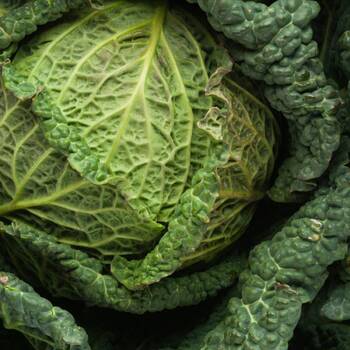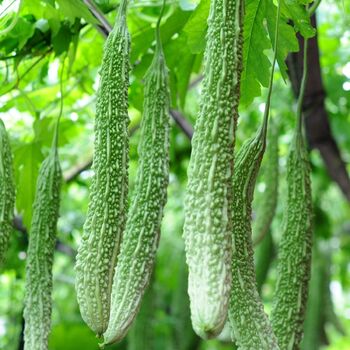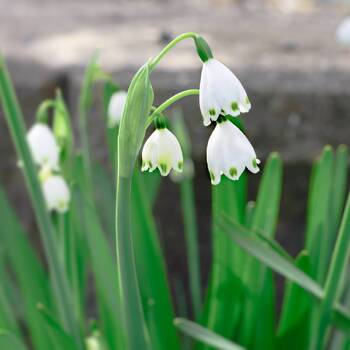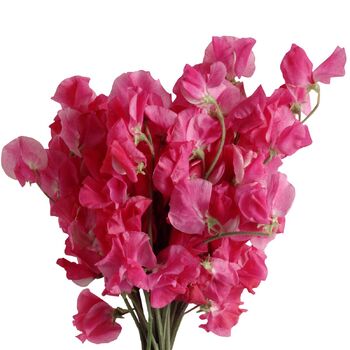Description
Seed Subscription: Vegetable, Temperate Climate, Winter 2024
Subscriptions are an excellent way to explore new seed varieties without having to spend time choosing the seeds yourself, and are perfect for busy gardeners, delivering seeds and all the information you need to plant them directly to your letterbox.
Each season we’ll choose a selection of seed varieties tailored to your climate, and send you the seeds plus a colour information sheet with photos, tips and sowing information - all you need to do is plant!
You are currently viewing a single season of seeds which can be purchased individually. To subscribe to a years worth of seeds click here.
Seeds included in this subscription:
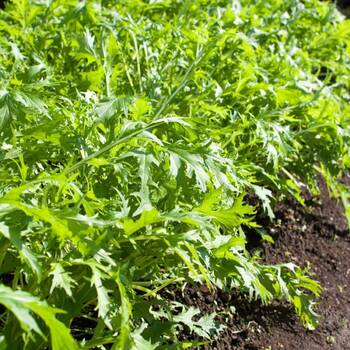
Mizuna
Serrated green leaves with a mild, spicy flavour. Can be used fresh in salads or cooked. Ideal for stir-fries, soups, and tolerates wet, cold conditions. Also known as "Japanese mustard". Suitable for microgreens and baby leaf production.
Sow direct or raise seedlings, 6mm. Germination 5-10 days @ 7-25°C.Annual. Rows 30cm, Spacing 30cm. 40-60 days.
Best months in Temperate Climates: MAR APR MAY JUN JUL AUG SEP OCT NOV (Click for full sowing chart, grow guide and more)
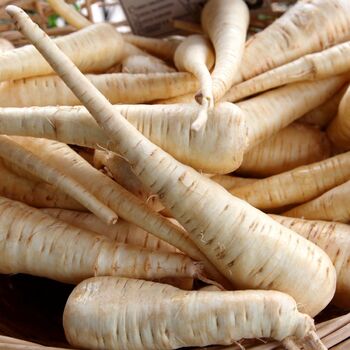
Parsnip- Melbourne White Skin
Australian heirloom parsnip grows long white roots. flavour improves in cooler weather, including frost, as sugars develop in the root. In cold climates, they can be left in the ground over winter for spring harvest.
Sow direct, 10mm. Germination 14-28 days @ 10-21°C.Biennial (usually grown as an annual). Rows 40cm, Height 60cm, Spacing 15-25cm. 90-130 days.
Best months in Temperate Climates: JAN FEB MAR JUL AUG SEP OCT NOV DEC (Click for full sowing chart, grow guide and more)
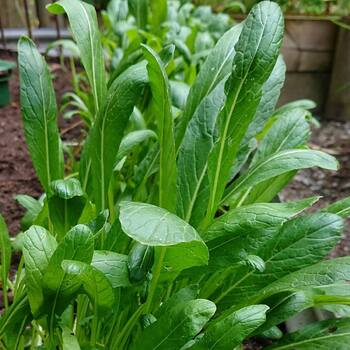
Mibuna
Dense clumps of fine white/green stalks with spoon-shaped leaves, mild mustard flavour. Used in salads, pickles, stir fries, soups, rice dishes. Fast-growing, cold-tolerant. Ideal for microgreens, baby leaf production. Ready in ~25 days.
Raise seedlings, 5mm. Germination 4-10 days @ 18-24°C.Annual. Height 35cm, Spacing 20cm. 55 days (25 days for baby leaf).
Best months in Temperate Climates: MAR APR MAY JUN JUL AUG SEP OCT NOV (Click for full sowing chart, grow guide and more)
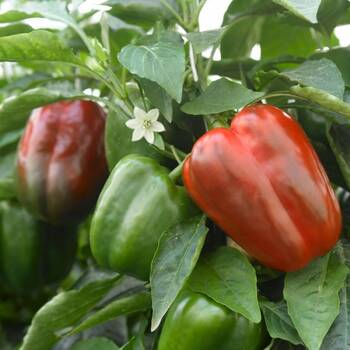
Capsicum- Californian Wonder
Plants produce bell-like fruit up to 10cm. Can be picked green or matured red. Thick sweet flesh. Can be eaten raw or cooked. Heavy bearing. Can be grown in containers. Capsicum is also known as "Sweet Pepper".
Sow direct or raise seedlings, 5mm. Germination 7-21 days @ 22-35°C.Perennial (grown as an annual in cool climates). Rows 100cm, Height 75cm, Spacing 50cm. 65-90 days.
Best months in Temperate Climates: AUG SEP OCT NOV DEC (Click for full sowing chart, grow guide and more)
-
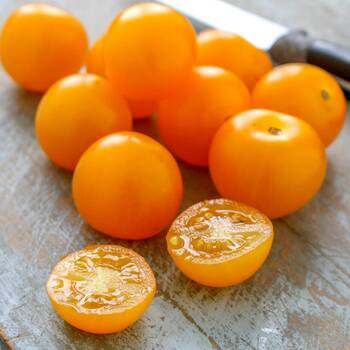
Tomato- Jaune Flamme
Climbing French heirloom tomato. Produces juicy, apricot-orange, golf-ball sized fruit. Early, productive crop with good disease and split resistance. High in Vitamin A. Great for drying, roasting, or fresh eating with a slight citrusy flavour.
Sow direct or raise seedlings, 5mm. Germination 5-10 days @ 21-27°C.Annual. Rows 80cm, Spacing 70cm. 70 days.
Best months in Temperate Climates: AUG SEP OCT NOV DEC (Click for full sowing chart, grow guide and more)
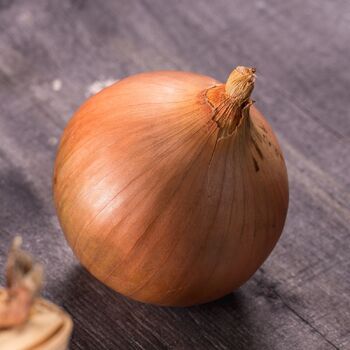
Onion- Australian Brown
Biennial (usually grown as an annual) onion with 4-5 layers of dark brown skin over a white-fleshed bulb. A high yielding onion with excellent storage. A late intermediate variety that requires around 12-14 hours of daylight to form bulbs.
Sow direct or raise seedlings, 5mm. Germination 7-10 days @ 20-25°C.Biennial (usually grown as an annual). Rows 40cm, Spacing 10cm. 180-240 days.
Best months in Temperate Climates: FEB MAR APR MAY JUN JUL AUG (Click for full sowing chart, grow guide and more)
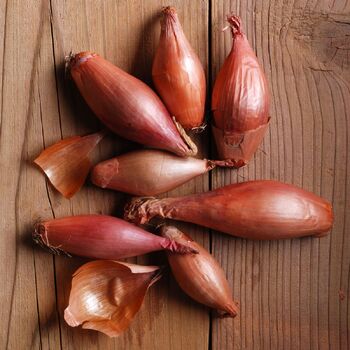
Shallot- Roderique Echalion
Biennial (usually grown as an annual) traditional French echalion with a long tapered shape and copper pink skin. Bulbs have a mild, sweet flavour and can be used in dressings, sauces, soups and stews, and eaten cooked, pickled or raw.
Sow direct or raise seedlings, 5mm. Germination 7-10 days @ 20-25°C.Perennial (usually grown as an annual). Rows 40cm, Spacing 5-10cm. 110-120 days.
Best months in Temperate Climates: FEB MAR APR MAY JUN JUL AUG (Click for full sowing chart, grow guide and more)
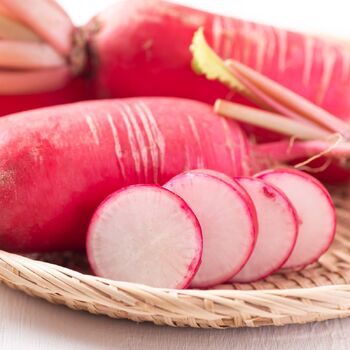
Radish- Mini Daikon Red F1
A biennial daikon-style radish with oval-shaped roots with bright red skin over tender, crisp white flesh. The flavour of the roots is both spicy and sweet. The leaves can also be eaten and have a hot, spicy flavour. Also known as 'Shunkyo'.
Sow direct, 10mm. Germination 3-14 days @ 8-30°C.Annual. Rows 30cm, Spacing 8cm. 50 days.
Best months in Temperate Climates: JAN FEB MAR APR MAY JUN JUL AUG SEP OCT NOV DEC (Click for full sowing chart, grow guide and more)
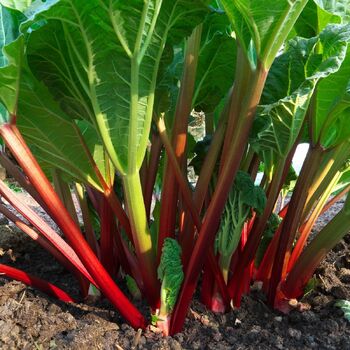
Rhubarb- Lider Red
Long stems that are red at the base and fade to light green at the leaves. Very productive variety. Excellent tart flavour; most commonly used in desserts. Good stewed and in pies and sauces.
Sow direct or raise seedlings, 12mm. Germination 7-14 days @ 20-23°C.Perennial. Rows 70cm, Height 150cm, Spacing 50cm. 365 days.
Best months in Temperate Climates: JAN AUG SEP OCT NOV DEC (Click for full sowing chart, grow guide and more)
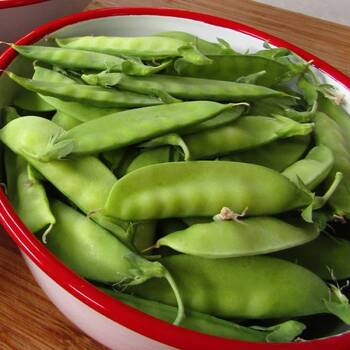
Snow Pea- Mammoth Melting
Climbing Snow Pea growing to 200cm. Flat, green, edible pods growing to 10cm by 2cm. Sweet and tender. Heavy cropping. Can be eaten raw or cooked; excellent in salads and stir-fries.
Sow direct, 20mm. Germination 7-21 days @ 5-25°C.Annual. Rows 50cm, Height 200cm, Spacing 10cm. 70-77 days.
Best months in Temperate Climates: FEB MAR APR MAY JUN JUL AUG SEP (Click for full sowing chart, grow guide and more)
Tips for gardening in winter:
Weeding and tidying: Rain helps weed seeds germinate and it is easier to remove them when the soil is damp. Be sure to remove weeds before they get a chance to mature and set seed, and ensure you get the weeds out roots and all. Hand tools are useful for small areas and hoes or tillers make the job go faster in larger gardens. Rake up fallen leaves so they don’t form a compact layer which can stop water reaching the soil. Add these extra leaves to your compost heap. Clear out any dead or diseased plants and to prevent the spread of disease, place this plant material in the bin rather than the compost bin.
Pruning: Check your tools and get them ready for winter pruning. Cleaning and sharpening your secateurs and pruning saws makes the job much easier, and a clean cut means there is less chance for disease to enter ragged wounds. It is easier to prune deciduous trees and shrubs in winter because you can see the structure of the plant more clearly. Remove any dead wood, and take out crossing branches or stems that might rub against each other.
Protect your plants from frost: If you live in a frost-prone area, protect your plants by covering them with frost cloth or hessian sacking. Remove this cover during the day to allow the sun to get to your plants and to help warm up the soil. Remember to cover them up again at night. Sheltering plants from cold winds also helps. You can build a temporary screen or windbreak, or plant close to a wall where plants will also benefit from the retained warmth at night.
Plot and plan: Use the down time in winter to review your garden and think about what you’d like to plant in the coming seasons. If you’re growing annuals, do you want to plant the same again or try some new varieties or colour schemes? If you’re growing veggies, remember that rotating your crops is a good idea to break the cycle or build-up of any pests and diseases that may be in the soil. This has the added benefit of reducing, or even eliminating, the need to spray with chemicals.
Pests and diseases to look out for in winter:
Slugs and snails: These pests can damage a wide range of plants, especially flower and vegetable seedlings. They are most active in the cooler wetter months, or when thunderstorms activate them in summer, and come out at night to feed. Controlling weeds and removing places that can harbour slugs and snails can be an effective way to control and reduce the number of these pests. If you choose to use bait, it is best applied in Autumn before snails get a chance to lay eggs. Most baits can be toxic to pets and other wildlife, so use any bait with caution.
Product code: SS_VEG_TEMP_WIN_2024
Contains
-

1 x Mizuna (Brassica juncea var. japonica)
Serrated green leaves have a mild but spicy flavour. Can be used fresh as a salad green or cooked as a leaf vegetable. Good in stir-fries and soups. Will tolerate wet and cold conditions. Sometimes called "Japanese mustard".
Good for microgreens and baby leaf production.
Life Cycle: Hardy Annual
Plant Height:
Position: Part or full sun, moist soil -

1 x Parsnip- Melbourne White Skin (Pastinaca sativa)
An Australian heirloom variety that grows long white roots. Flavour will be improved if left in the ground over cooler weather, including frost, which allows sugars to develop in the root. In cold climates parsnips can be left in the ground over winter to harvest in early spring. Parsnips have a sweet nutty flavour and can be steamed, baked or used to make chips or soup.
Life Cycle: Frost Hardy Biennial (usually grown as an annual)
Plant Height: 60cm
Position: Full sun, loose friable soil -

1 x Mibuna (Brassica rapa japonica)
Plants form dense clumps of fine white or pale green stalks with spoon shaped green leaves that have a mild mustard like flavour. Leaves are most commonly used as a salad green but are also excellent pickled or cooked in stir fries, soups and rice dishes. Fast growing. Cold tolerant. Good for microgreens. Good for baby leaf production; ready in around 25 days.
Life Cycle: Frost hardy Annual
Plant Height: 35cm
Position: Part or full sun, moist soil -

1 x Capsicum- Californian Wonder (Capsicum annuum)
Plants produce bell-like fruit up to 10cm. Can be picked green or matured red. Thick sweet flesh. Can be eaten raw or cooked. Heavy bearing. Can be grown in containers. Capsicum is also known as "Sweet Pepper".
Life Cycle: Frost tender Perennial (grown as an annual in cool climates)
Plant Height: 75cm
Position: Full sun, moist well drained soil -

1 x Tomato- Jaune Flamme (Solanum lycopersicum)
Climbing (indeterminate) variety. French heirloom tomato producing juicy round apricot orange golf-ball sized fruit. Early cropping productive variety with good disease and split resistance due to its thick skin. Fruit contains high levels of Vitamin A due to its orange colouration. Great for drying, roasting or eating fresh, has a slight citrusy flavour.
Life Cycle: Frost tender Annual
Plant Height:
Position: Full sun, moist well drained soil -

1 x Onion- Australian Brown (Allium cepa)
Biennial (usually grown as an annual) onion with 4-5 layers of dark brown skin over a white-fleshed bulb. A high yielding onion with excellent storage.
A late intermediate variety that requires around 12-14 hours of daylight to form bulbs.
Life Cycle: Hardy Biennial (usually grown as an annual)
Plant Height:
Position: Full sun, well drained soil -

1 x Shallot- Roderique Echalion (Allium cepa var. aggregatum)
Biennial (usually grown as an annual) traditional French echalion with a long tapered shape and copper pink skin. Bulbs have a mild, sweet flavour and can be used in dressings, sauces, soups and stews, and eaten cooked, pickled or raw. The green leaves can also be eaten like a spring onion, leaving at least half of the leaf to provide energy for the bulbs to grow.
Echalions or echalots are crosses between onions and true shallots. Also known as 'Banana Shallot'. This is a long day variety suited to cold climates. Matures mid season.
Life Cycle: Hardy Perennial (usually grown as an annual)
Plant Height:
Position: Full sun, well drained soil -

1 x Radish- Mini Daikon Red F1 (Raphanus sativus)
A biennial daikon-style radish with oval-shaped roots with bright red skin over tender, crisp white flesh. The flavour of the roots is both spicy and sweet. The leaves can also be eaten and have a hot, spicy flavour. This daikon is fast growing and slow to bolt.
This type of radish is used in northern Chinese cuisine and is also known as 'Shunkyo'.
Life Cycle: Hardy Annual
Plant Height:
Position: Full sun, well drained soil -

1 x Rhubarb- Lider Red (Rheum rhabarbarum)
Perennial vegetable growing to 150cm. Very quick growing plants that can be harvested lightly in their first year. Long stems that are red at the base and fade to light green at the leaves. Very productive variety. Excellent tart flavour; most commonly used in desserts. Good stewed and in pies and sauces. DO NOT EAT LEAVES, Rhubarb leaves are poisonous.
Life Cycle: Hardy Perennial
Plant Height: 150cm
Position: Part or full sun, moist well drained soil -

1 x Snow Pea- Mammoth Melting (Pisum sativum)
Climbing Snow Pea growing to 200cm. Flat, green, edible pods growing to 10cm by 2cm. Sweet and tender. Heavy cropping. Can be eaten raw or cooked; excellent in salads and stir-fries.
Life Cycle: Hardy Annual
Plant Height: 200cm
Position: Full sun, moist well drained soil
Shipping
We deliver Australia wide.
All orders are dispatched from our warehouse in Knoxfield, Victoria, Australia.
We do not deliver overseas.
Shipping cost is calculated using all the items in your shopping cart and your delivery postcode. The table below outlines the delivery options and costs.
Order dispatch time is currently 1-3 business days plus delivery time.
Please note we are unable to guarantee specific delivery dates or delivery timeframes, all delivery times are estimates only.
| Order contains: | Delivery options: | Delivery cost per order | |
|---|---|---|---|
| VIC, NSW, ACT, QLD, TAS, SA, NT | WA | ||
| Small seed packets ONLY - | Economy Delivery | $3.00 or FREE on orders over $25 | $5 |
| Parcel Delivery | Capped rate of $8.99 | ||
| Express Delivery | $15.00 | ||
|
BULK seed, garden supplies, tools, or accessories - |
Parcel Delivery |
Capped rate of $8.99 |
|
|
Express Delivery |
Starting from $15.00 (Calculated by weight) |
||
| Live Plants - | Live plants | Capped rate of $10.00 | |
*All orders sent to Western Australia are subject to mandatory inspection and fees by Quarantine WA. These fees are included in all shipping costs above.
**We will replace all orders that are lost or damaged in transit however we will not replace or refund orders simply because they were delivered later than estimated. Full details here.
Ratings & Reviews
Be The First To Review This Product!
Help other The Seed Collection Pty Ltd users shop smarter by writing reviews for products you have purchased.




.png)



